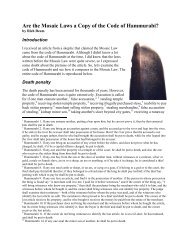Coming to Grips with the Early Church Fathers - Evidence for God ...
Coming to Grips with the Early Church Fathers - Evidence for God ...
Coming to Grips with the Early Church Fathers - Evidence for God ...
Create successful ePaper yourself
Turn your PDF publications into a flip-book with our unique Google optimized e-Paper software.
<strong>Coming</strong> <strong>to</strong> <strong>Grips</strong> <strong>with</strong> <strong>the</strong> <strong>Early</strong> <strong>Church</strong> Fa<strong>the</strong>rs’ Perspective on Genesis John Millam<br />
escha<strong>to</strong>logical fervor. 40 As time went on, age estimates continued <strong>to</strong> be adjusted <strong>to</strong> stay <strong>with</strong>in<br />
<strong>the</strong> six-thousand-year framework. In his own research, Bradshaw writes, “For <strong>the</strong> purposes of<br />
our present study <strong>the</strong> important point <strong>to</strong> note is that it was ecclesiastical concern over<br />
escha<strong>to</strong>logy ra<strong>the</strong>r than arguments that <strong>the</strong> world was more ancient that caused <strong>the</strong>se changes.” 40<br />
In <strong>the</strong> fifth century, Jerome’s Latin Vulgate translation res<strong>to</strong>red <strong>the</strong> ages at fa<strong>the</strong>rhood (in <strong>the</strong><br />
Genesis genealogies) given in <strong>the</strong> Hebrew text. So as <strong>the</strong> Vulgate became accepted, dates <strong>for</strong><br />
creation subsequently shifted <strong>to</strong> around 4000 BC. Following <strong>the</strong> Jewish model, scholars placed<br />
Jesus’ first coming around <strong>the</strong> four thousandth year, but this placed his second coming in what<br />
was <strong>the</strong>n <strong>the</strong> far future (around 2000 AD).<br />
Not surprisingly, <strong>the</strong> creation-week pattern waned in popularity during <strong>the</strong> Middle Ages, since it<br />
no longer predicted Christ’s return as imminent. Interestingly, James Ussher and John Lightfoot<br />
revived this pattern in <strong>the</strong> mid-seventeenth century by assigning 4004 BC as <strong>the</strong> date <strong>for</strong><br />
creation. That date is no accident because it placed Jesus (c. 4 BC) exactly four thousand years<br />
after Adam. Its popularity was assured because Christ’s second coming would again be expected<br />
<strong>to</strong> be only a few centuries away.<br />
Analysis<br />
Much of this discussion may seem <strong>to</strong> provide Mook <strong>with</strong> substantial support <strong>for</strong> his claim that<br />
<strong>the</strong> fa<strong>the</strong>rs were young-earth creationists. However, a closer examination reveals a more complex<br />
s<strong>to</strong>ry.<br />
Nonliteral origin. Scripture does not teach <strong>the</strong> chronological framework or <strong>the</strong> idea of<br />
<strong>the</strong> world lasting just 6,000 years. Instead, this model is based on typological comparison<br />
ra<strong>the</strong>r than a literal one. (Ironically, Mook does acknowledge that <strong>the</strong> creation-week<br />
pattern involves “typological interpretation” but does not admit this fact makes <strong>the</strong><br />
framework nonliteral.) 41 Additionally, <strong>the</strong> use of Psalm 90:4 <strong>to</strong> equate a day <strong>to</strong> a<br />
millennium is not hermeneutically justified and is, <strong>the</strong>re<strong>for</strong>e, not a literal interpretation. 42<br />
While <strong>the</strong> Bible certainly does teach that Jesus will return, it does not in any way affirm<br />
this particular escha<strong>to</strong>logical model.<br />
Popular tradition only. Mook appeals <strong>to</strong> <strong>the</strong> fact that this 6,000-year model was widely<br />
held (by at least 8 fa<strong>the</strong>rs) as strong support <strong>for</strong> his contention that <strong>the</strong> fa<strong>the</strong>rs were<br />
young-earth creationists. But popularity does not determine truth. Many popularly held<br />
beliefs are later rejected. For example, many of <strong>the</strong> early church fa<strong>the</strong>rs taught that Isaiah<br />
14 and Ezekiel 28 were written about Satan, but Martin Lu<strong>the</strong>r and later <strong>the</strong>ologians<br />
correctly pointed out that <strong>the</strong>se passages refer primarily <strong>to</strong> <strong>the</strong> kings of Babylon and<br />
Tyre. 43<br />
40. Robert I. Bradshaw, Creationism and <strong>the</strong> <strong>Early</strong> <strong>Church</strong>, last updated January 25, 1999, chapter 3,<br />
http://www.robibrad.demon.co.uk/Contents.htm.<br />
41. James Mook, “The <strong>Church</strong> Fa<strong>the</strong>rs on Genesis, <strong>the</strong> Flood, and <strong>the</strong> Age of <strong>the</strong> Earth,” 39.<br />
42. Psalm 90:4 is clearly a simile (a comparison using “like” or “as”) <strong>to</strong> illustrate that that which we would consider<br />
a very long period of time (a thousand years) is <strong>to</strong> <strong>God</strong> like a brief period of time (a day or a watch in <strong>the</strong> night).<br />
Nothing in this or any o<strong>the</strong>r passage remotely suggests that we can equate a solar day <strong>to</strong> a millennium.<br />
43. Bradshaw, Creationism and <strong>the</strong> <strong>Early</strong> <strong>Church</strong>, chapter 8.<br />
Page 13 <strong>Evidence</strong> <strong>for</strong> <strong>God</strong> from Science






